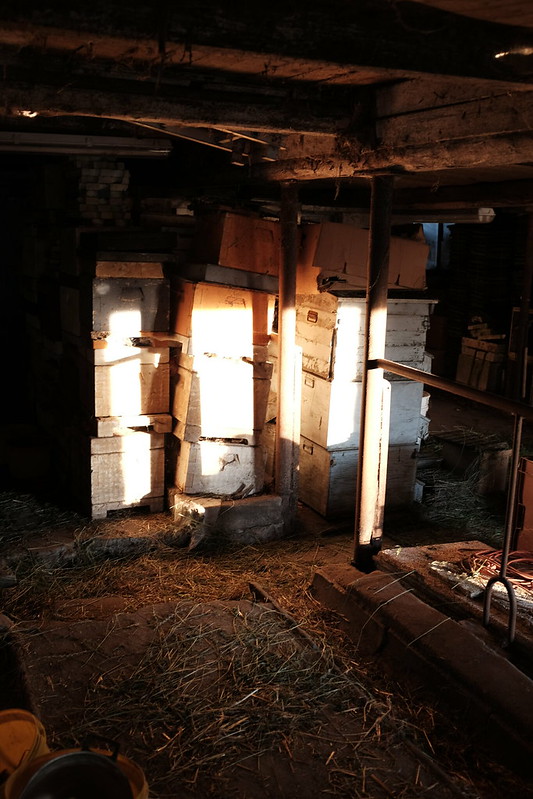Don't stand between the bees and the sun, and if there is thunder in the air they'll become aggressive… We must always leave enough honey in the hive for the bees to eat. When we get the honey-loaded frames to the house remember to look all around us to make sure no bees have followed us, if they know where we've taken the honey they'll go back and tell the colony.
There are 50-60 thousand bees per hive.
The worker bees are all female. They perform different roles: House bees clean up the hive and polish cells ready for the queen to lay her eggs. Guard bees protect the hive from wasps and thieving bees that might try to enter. 0.5% of the swarm are guard bees and these are the most likely to sting. Foraging bees go out to collect nectar; when they find a fab nectar source, they return to the hive and dance in a circle on the frame. The angle that they dance across the circle indicates the angle that the nectar source is to the sun, 60 degrees to the right = 60 degrees to the right of the sun. They dance in a bum waggling zig zagging, which communicates the distance from the hive to the source. Enzymes in the foraging bees stomachs change nectar into honey which they then regurgitate and give to house bees who put it into the cells. Foragers also carry pollen in flaps of skin on their back legs to feed to young bees. Nurse bees are the youngest bees in the colony, they're not out foraging yet and can produce royal jelly by eating honey, which they feed to the lava. Whether or not a worker bee becomes a queen depends on how much royal jelly she is fed, and how big her bedroom is.
After 3 weeks in summer or 5 months winter, the worker bees wings become worn, they can't fly, and die. During their lives most will work all of the different worker functions.
Drone bees are male, they stay inside the hive eating until they are mature, when they gather at mating points in the air outside the hive. Nobody is really sure about how they meet and why (like a pub). Young queenie leaves the hive and mates with 8-12 drones, tearing their penises and abdomens out in the process. In these 8-12 shags she saves enough sperm for 5 years of egg laying.
The queen decides whether or not she wants to fertilise her own egg with sperm in her bank; a fertilised egg makes a worker bee, non-fertilised makes a drone.
If there is more than one queen in a hive, they whistle to each other until one finds the other and they fight to the death.
The drones have no stinger; they are only allowed inside the hive in case a replacement queen is needed, so when Autumn arrives, the female workers slaughter the male drones and throw them outside, dragging them by their mandibles. Some drones are kept so that if an emergency queen-replacement has to be done over winter, she has some available mates to fill her sperm bank.
In Summer, the queen lays 2000 eggs per day, depending on how much nectar is being brought in. The wax comes from a gland in the exoskeleton. Wax will only be produced when nectar flow is good. Wax-building means the hive is expanding. During Winter, bees keep a very small number of eggs alive.
View Larger Map










